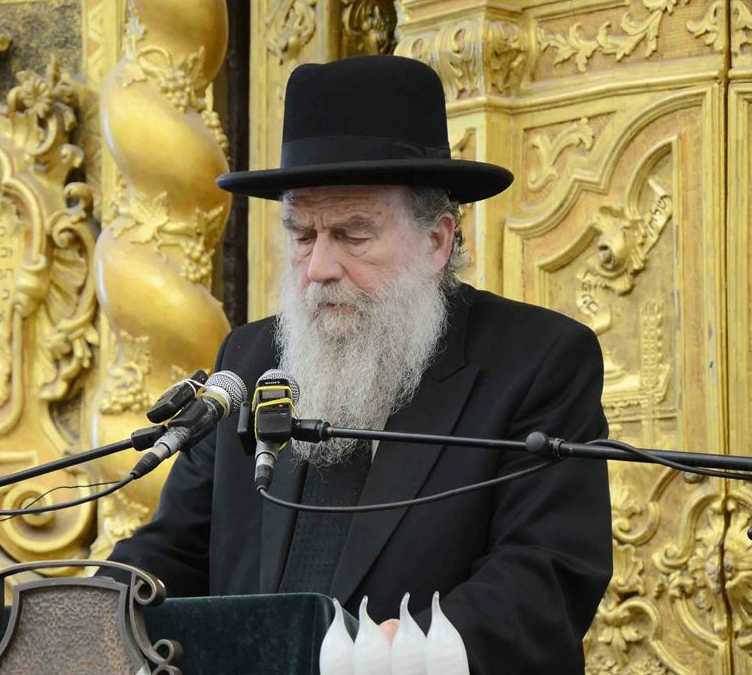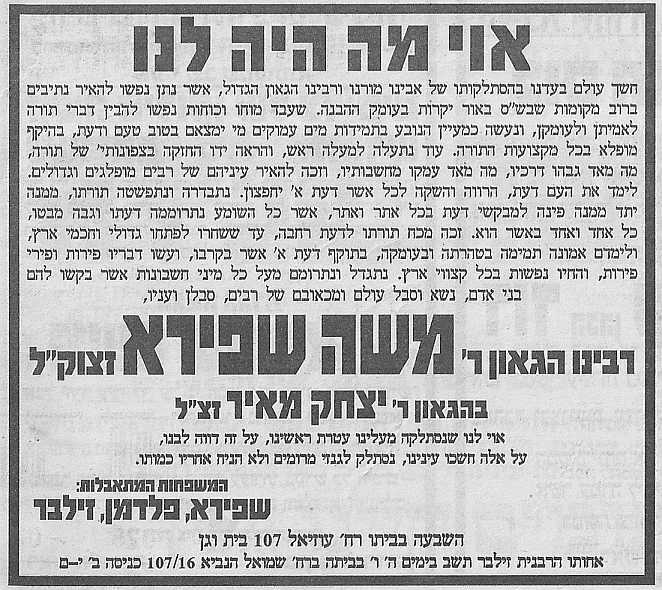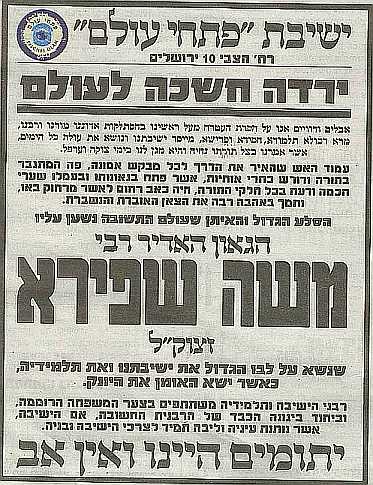


  |
|
| ||||
|
NEWS |
|||
| From Our Archives |
|
Chazal Tell Us How to Overcome Yishmoel
by Rabbi Mordecai Plaut based on a shiur of a rosh yeshiva in Yerushalayim
With the threats faced by those living in the Middle East, and around the world, from those of Arab extraction, the following penetrating analysis sheds light on important characteristics of the struggle with Yishmoel as described by Chazal. This is not to suggest that every Arab is as detailed here, but that the essential features of the contest are as explained, and the steps we must take -- which are matters of our personal and private avodoh -- are as outlined here.
The following is based on a tape of a shiur that was delivered almost twenty years ago.
That rosh yeshiva was HaRav Moshe Shapira zt"l. |
In 5739 he returned to Eretz Yisrael where he began toiling tirelessly on his shiurim and famous Torah essays, while launching the world of Teshuva and outreach to produce generations of disciples to whom he transmitted the bulk of his famous Torah wisdom and approach in the incisiveness of Torah knowledge which would broaden the boundaries of Torah and Halacha for the coming generations.
Aside from the thousands of Torah scholars which he brought forth in Eretz Yisrael and abroad through his numerous essays and shiurim, he was a man of whom can be said that he established the Teshuva movement for the distanced Israeli public. He was very instrumental, already over fifty years ago, in creating a basis and direction for the beginnings of Yeshivas Ohr Somayach for Israeli baalei teshuva through his profound and illuminating shiurim, an approach which is maintained to this day. He succeeded in endearing Torah and bequeathing its depth and sweetness to those removed from it, thus meriting the epithet of "Gedol Dei'ah" for tens of thousands.
He was one of the first to work to help the large, lost Jewish community of Russia. He founded the organization Mesillos Aliya which reached out to Russians to bring them closer to the heritage that they had lost in the atheistic Soviet Union. He used to go to shuls and yeshivos to arouse people to help to deal with the Russian Jews.
As long as yeshivas Toras Chaim in Moscow has been in operation, he was among the great Torah personalities who came regularly to bring his unique influence to the students. He used to spend every Pesach in Russia with the talmidim of the yeshiva. On many occasions he sat in the beis medrash there for entire sedorim and even late into the night, giving shiurim and sichos and laying things out with seemingly inexhaustible patience.

In one of his meetings with Maran the Rosh Yeshiva HaRav A.Y.L. Shteinman, Rav Moshe told him that yeshivas Toras Chaim (of which HaRav Shteinman is the nosi) is one of the central pillars of Klal Yisroel today, and shows the possibility of reviving the dead bones.
Rav Moshe was the rav muvhak of HaRav Yosef Citruk zt"l the former Chief Rabbi of France. Rav Moshe provided him with advice and counsel as he served successfully as Chief Rabbi of that large community.
Rav Moshe was like a reservoir that does not lose a drop, in all areas of Torah. The sources from which he drew included Toras Hanigleh and Toras Hanistar, and often his Kabbalistic sources were evident only to those who were already familiar with that material. He was able to couch deep concepts in terms that were accessible to a wide range of eager students. He also gave shiurim which were restricted to talmidim that he approved in advance.
He worked without any personal interest, as a servant of Hashem with no other goal but to do the will of his Maker. His noble demeanor impressed all who came in contact with him.
He was beloved of all who came in contact with him, just as he was doubtless beloved by the Creator. He dealt with many issues and problems all the time, and many who turned to him with personal problems and distress, later saw how he took their problems to heart and would fast and weep over their issues.
In recent years he know sickness and pain, but nonetheless he maintained his full schedule of meetings and shiurim until last Av. Since then he could no longer continue, and thousands prayed for his recovery. This past weekend he left us. He was niftar on 9 Teves, a day which he usually marked with a special shmuess since it is said that the founder of Christianity was born on that day.
HaRav Moshe Shapira zt"l is survived by his wife who was at his side throughout his life, his sons: HaRav Avrohom of Yerushalayim, HaRav Shmuel a rosh kollel in Romema, and HaRav Shlomo of Yerushalayim, as well as his son-in-law HaRav Aryeh Feldman. He is also survived by numerous grandchildren and great-grandchildren, who carry on his traditions.

A view of the levaya in Ramat Shlomoh
The Levaya
At 11 in the morning on the fast of the Tenth of Teves, the beis medrash in Ramat Shlomo began to fill up, as well as the streets outside. Those whom he had touched were of all ages and of all communities. The levaya began with Tehillim.
HaRav Boruch Dov Povarsky
The first maspid was HaRav Boruch Dov Povarsky shlita, who recalled his friendship over many years with the departed gaon. He cited the gemora in Bovo Basra that says that Rabbi Yochonon ben Zakai mastered all Scripture, Mishna, Gemora, Halochos, Aggodos, Dikdukei Torah and Sofrim, Kal Vachomers, and Gezeiros Shovos. HaRav Povarsky asked how one can achieve all these treasures. He explained it with a thought from Rabbenu Yonah in Ovos on the mishna, "Who is a Chochom? One who learns from everyone." Rabbenu Yonah says that one who knows a lot of Torah but does not love it. Only one who loves it so that he is willing to learn from everyone is a chochom. This is what we saw in Rav Moshe. Even as a youth he loved the Torah with all his heart. That is how he managed to get such a command of Torah, since his only desire was to seek out chochmoh and to pass it on to others. That is how he reached the madreigoh of Rabbi Yochonon ben Zakai.

The Tanna says that Rabbi Yochonon ben Zakai had 5 talmidim. He certainly had thousands of talmidim. Why does it say that he had 5? Because these were especially dedicated to him and they grew from his influence. Rav Moshe had a tremendous love for his talmidim and they cleaved to his learning and his ways. He learned this from Slobodka (Chevron). It is well known that the Alter used to fast for the success of his talmidim, and Rav Yeruchom used to say that his hair turned white because of his worrying about his talmidim.
Chazal spoke of the light of the Menorah in the Beis Hamikdash. They said that before he would give over Torah to Klal Yisroel, Moshe Rabbenu would go into the Mishkan to look at the Menorah. What exactly did he see there?
Chazal say that Aharon was disappointed that he did not have a share in the korbonos of the Nesi'im at the dedication of the Mishkan, and that HaKodosh Boruch Hu consoled him and said that he will have something greater than that since he will have something eternal, namely, cleaning and lighting the Menorah in the Beis Hamikdash. But know the Beis Hamikdash is destroyed so how does Aharon have this forever?
The light that was created on the First Day of Creation was hidden, it says, to save it for the Tzaddikim in the Osid Lovo. This light is the light that tzaddikim achieve through their learning Torah. Moshe Rabbenu used to look at the Menorah to recall the Hidden Light so that he could give that over to Klal Yisroel.
Rav Moshe zt"l's Torah came from his heart. Since he learned Torah with kedushoh and taharoh he was successful in his goal of spreading the Light of Torah in the world. He energized the Teshuvoh Revolution by injecting some of the Hidden Light, knowing that this is what would truly attach them to the Torah world.
He was truly unique in his generation in his success in bringing people close to Torah. He had siyata deShmaya in this as he was able to spread the light of Torah. The Rambam says in his Peirush Mishnayos that before the final Geula the world will be full of dei'oh es Hashem. Rav Moshe was the Rebbe of them all. Everyone must mourn him as an only child. All Klal Yisroel mourns, and each individual mourns his individual loss.
It says that Yaakov Ovinu did not die since he left his son Yosef in his place. When he thought that Yosef was lost, he said that he has no life and would go to oblivion. Rav Moshe was truly one who transmitted the tradition and was chosen by Hashem to do so. This should be a nechomoh to his Rebbetzin shtichyeh and the entire family, who go in his footsteps. May we merit, Bila hamoves lonetzach.
HaRav Yehuda Ades
HaRav Yehuda Ades, rosh yeshiva of Kol Yaakov in Bayit Vegan, said what Dovid Hamelech said of Yonoson: Tzar li olecho ochi, no'amto li me'od. HaRav Avrohom Farbstein once asked, what was Dovid Hamelech saying? Yonoson was one of the gedolei hador, and is that all he could say, that Yonoson pleased him very much? But it must be that this praise from Dovid his a very high comment, and only one who lived on a truly elevated madreigoh would have merited it.
The posuk says, My Beloved has gone to his garden to gather roses. Chazal have described the experience of the Malach Hamoves on the day of death and it is fearful. If the experience can be compared to gathering roses, it would seem that those who are thus described do not experience the frightful Malach Hamoves.
Aside from the mourning of all Klal Yisroel, we in Bayit Vegan cry woe is us for our loss, and in particular Yeshiva Kol Yaakov. When he would talk every year after getting Chosson Bereishis he would give is strength to last until Chanukah. I can testify that 55 years ago when I came to Bayit Vegan Rav Moshe already stood out as a great man. All his life he walked modestly at the side of the road. But all over the world he has talmidim who feel they have lost their father.
HaRav Aviezer Pilz
Klal Yisroel cries: "Woe is the Holy Land which has lost a great man. Woe to Yerushalayim and his many talmidim who have lost their leader."
When Eliahu had his personal Maamad Har Sinai, it says that first there was a great stormy wind that dismantles mountains and breaks boulders. But Hashem was not in the great noise. Then there was a fire, but Hashem was not in the fire. Then there was a silent thin voice. Rashi says that this last is a kol that comes from silence and one does not hear the kol itself.
There are two levels. There is thundering to the nations of the world. But to the prophets of Yisroel there was a silent thin voice. We learn from this that this silent thin voice teaches more than the great noise that destroys mountains. Because as strong as a thundering noise is, it has a limit. And fire, as strong as it is, it has a limit. But silence has no limit. When we want to describe the Ein Sof, there is just silence without any additional kol. This is what Rav Moshe was. We saw a silence that was entirely kol. A silence that was the kol Hashem in koach and hodor, that could break cedar trees and anything.
The posuk says, "The King has brought me into his inner chambers." Chazal said that one can merit to achieve the inner sanctums of Torah. Rav Moshe, who was so repulsed by externalities, and whenever there was a drop of chitzonius he said that it was not for him, because he was completely pnimiyus. He was the kol of the silence. And therefore he entered the inner sanctums of the Torah.
If you want to be with your G-d in the inner rooms of Torah, this will happen only if there is hatznei'a leches, if you stick strictly to modesty. Whenever there was publicity or chitzonius it was a contradiction to his essence. He would enlighten sugyos with the same clarity already in his youth. We were zoche to be meshamesh him in his youth and we felt that he had been taken by the King into His inner chambers.
The chambers of his heart, and his work on the hidden part of Torah, come from the same power of pnimiyus that he had as a person who worked on Torah shebe'al peh and also lived with the nistar. Since his own pnimiyus demanded to access the sod of Torah, he was zoche to the nistar. Rashi says in Shabbos that "talmid chochom" refers to one who is occupied to understand the sod. The same koach that gave him a grasp of the nigleh part of Torah gave him also the siyata deShmaya to reach the innermost recesses of the Toras Hanistar. HaRav Shimshon Pincus zt"l once told me that among the people of Kabboloh of our generation, Rav Moshe is literally in the first place.
One of the many expressions of mourning, chosen for illustrative purposes

Chazal say that the reward of the house of mourning is crying. This is a time that is auspicious to be zoche to a light from Heaven. Everyone should ask for a little pnimiyus. If we achieve some inner pnimiyus we can reach the chambers of Torah.
When he had just started to be marbitz Torah, he came to Tifrach even though there were very few bochurim there. But those who sought the sod of Torah came there. And he left Yerushalayim with all his prestige there, and went to a small town in the Negev, where he could remain pnimy without any distractions.
May Hashem help us to cleave to this pnimiyus and may we merit, Or Chodosh al Tzion to'ir.
The Family
His son-in-law HaRav Aryeh Feldman said that of his Thursday night shiur there were talmidei chachomim who went to it for over twenty years, and there were baalei teshuva coming for their first time. Amazingly, at the end everyone came out with something new to him.
His son HaRav Shmuel said that after his recent operations, when he was still under the influence of the sedation, he murmured over and over: His whole being was to increase kvod Shomayim. I asked him: Who? And he answered: Moshe Rabbenu. We do not know how we will be able to preserve all the ruchniyus that he spread in his life. But we must strive to think all the time how we can increase the kvod Shomayim.
His son HaRav Shlomoh said that his father lived with emunah. It was emunah that was the basis of his life.
His son HaRav Eliahu said that there was so much hidden in his heart and we can cry for ourselves who will never learn all of it.
He should be a meilitz yosher for our mother and the family and the talmidim.
After Kaddish the levaya proceeded to the burial on Har HaZeisim.
T.N.T.B.H.
All
material on this site is copyrighted and its use is
restricted.
Click here
for conditions of use.